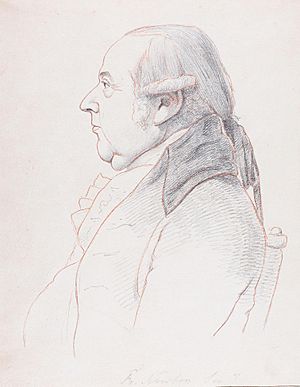Francis Milner Newton facts for kids

Francis Milner Newton (born in London in 1720, died in Corfe on August 14, 1794) was an English artist. He was known for painting portraits of people. He also became the very first secretary of the important Royal Academy of Arts.
Contents
Early Life and Art Training
Newton learned art from Carl Marcus Tuscher, a German artist who lived in England. He also studied at Hogarth's St Martin's Lane Academy. This was a famous art school in London.
Working to Create an Art Academy
Early Attempts to Form an Academy
In 1753, Newton joined other artists who wanted to create a national art academy. This first plan did not work out.
Two years later, in 1755, a group of artists tried again. They formed a committee, and Newton was chosen as their secretary. This attempt also failed.
Forming the Society of Artists
A more successful meeting happened in 1759 at a place called the Turk's Head tavern. A committee of sixteen artists was formed, and Newton was again their secretary.
The next spring, this committee held an art exhibition. It was at the Society of Arts gallery. Newton showed one of his portraits there.
Splits Among Artists
After some disagreements, the artists decided to hold their next exhibition in 1761 at a different location. By then, the artists had split into two groups.
One group called themselves the "Society of Artists of Great Britain." They held their exhibition and named Newton as their secretary. The other group showed their art at the Society of Arts. Both groups continued to hold yearly exhibitions for several years.
In 1765, the Society of Artists of Great Britain received a special charter. This made them "The Incorporated Society of Artists." Newton continued to serve as their secretary.
Founding the Royal Academy
In 1768, another split happened within the Incorporated Society. Newton and some other leaders were removed from the group.
These artists who were removed decided to form a new society. They gained the support of King George III. This led to the creation of the Royal Academy of Arts. Sir Joshua Reynolds became its first president.
Newton was chosen as the Royal Academy's first secretary. He held this important job until he resigned in 1788.
Newton's Legacy as Secretary
John Evan Hodgson, who later became a librarian at the Royal Academy, spoke about Newton. He said that Newton was not a very famous artist. However, he held a very respected position and did his job well. Hodgson noted that Newton lived in exciting times and was friends with great artists. He felt that Newton's memory should be respected, even though not much is known about him.
Newton showed eight of his portraits at the Royal Academy's exhibitions. He exhibited between 1769 and 1774. His address was listed as Mortimer Street at first, then Portland Street.
Later Life and Death
Newton lived in Hammersmith, west London, for several years. Later, he inherited a property called Barton Grange in Corfe. This property belonged to his mother's family. He moved there and spent the rest of his life in Corfe.
Francis Milner Newton died on August 14, 1794, and was buried in Corfe. He had one child, a daughter named Josepha Sophia.


